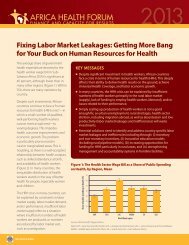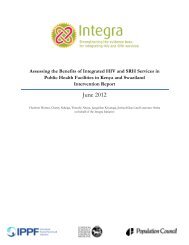ujh78
ujh78
ujh78
You also want an ePaper? Increase the reach of your titles
YUMPU automatically turns print PDFs into web optimized ePapers that Google loves.
difference of 16 percentage points. Burkina Faso, Burundi, Cameroon, Mali, and Nigeria also had an<br />
underweight prevalence that was at least 10 percentage point higher in rural than in urban areas.<br />
The role of the household head’s sex and age<br />
In one-third of these sub-Saharan African countries, the prevalence of underweight was higher for<br />
children living with a female household head than for children living with a male household head (see<br />
Figure 2.15). Namibia experienced the most variation, with an underweight prevalence of 28% among<br />
children living with a male household head and 20% among children living with a female household<br />
head, a difference of 8 percentage points (see Table 2.4).<br />
The prevalence of underweight was higher for children living with a household head at least age<br />
50 in half of these countries (see Figure 2.16). Burundi (household head under age 50: 34% versus<br />
household head age 50 or older: 40%) and Namibia (20% versus 26%) had the largest variation—around<br />
six percentage points (see Table 2.4).<br />
Variations during the last 13 years<br />
As Table 2.4 indicates, in the last 13 years the prevalence of underweight has decreased in all 18<br />
countries with two surveys, with the exception of Kenya. The greatest reductions occurred in Burkina<br />
Faso (2003: 38% and 2010: 30%), Rwanda (2005: 23% and 2010: 15%), and Zambia (2001-02: 28% and<br />
2007: 19%), a difference of more than 7 percentage points in each case (see Figures 2.17 and 2.18).<br />
12








